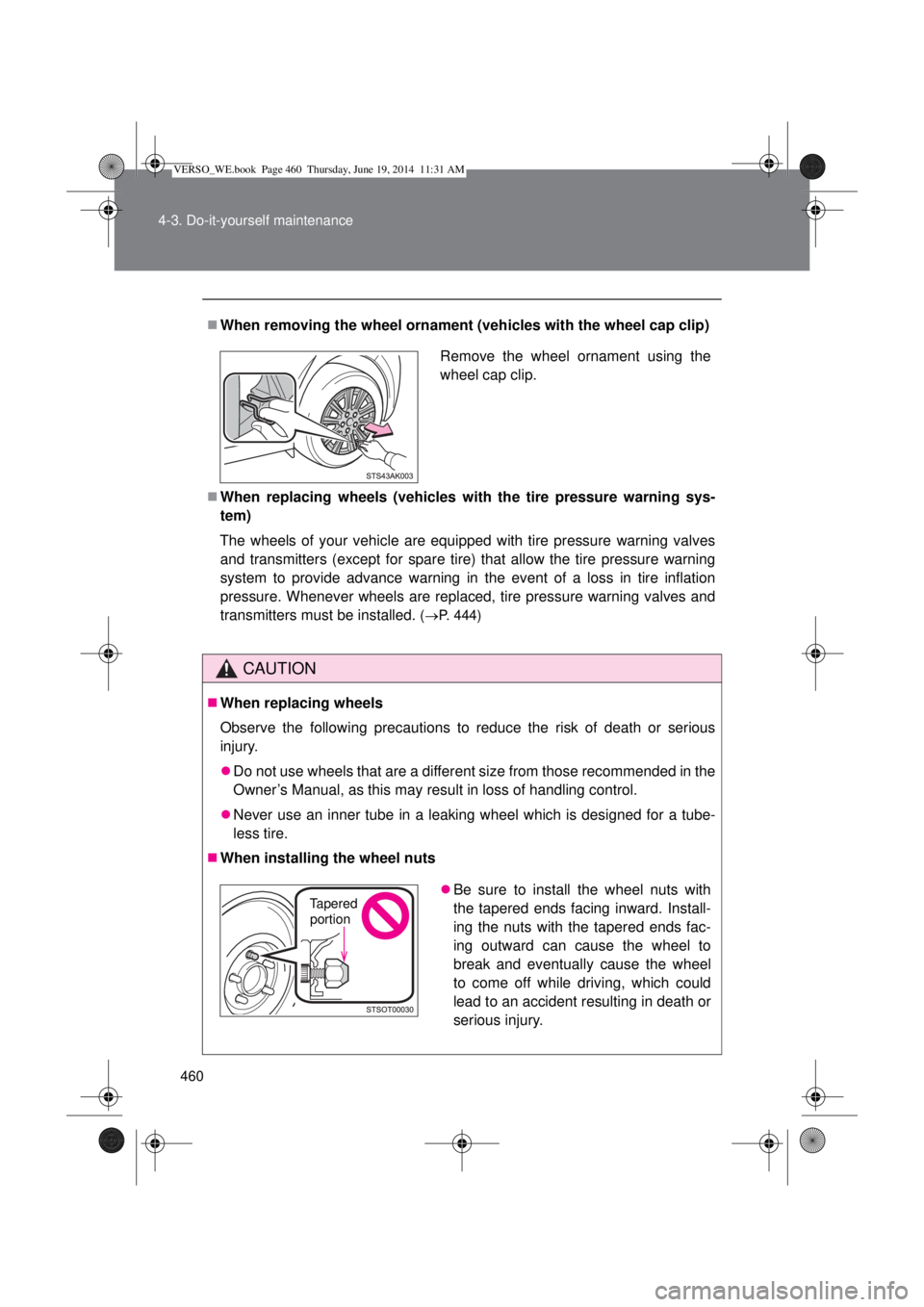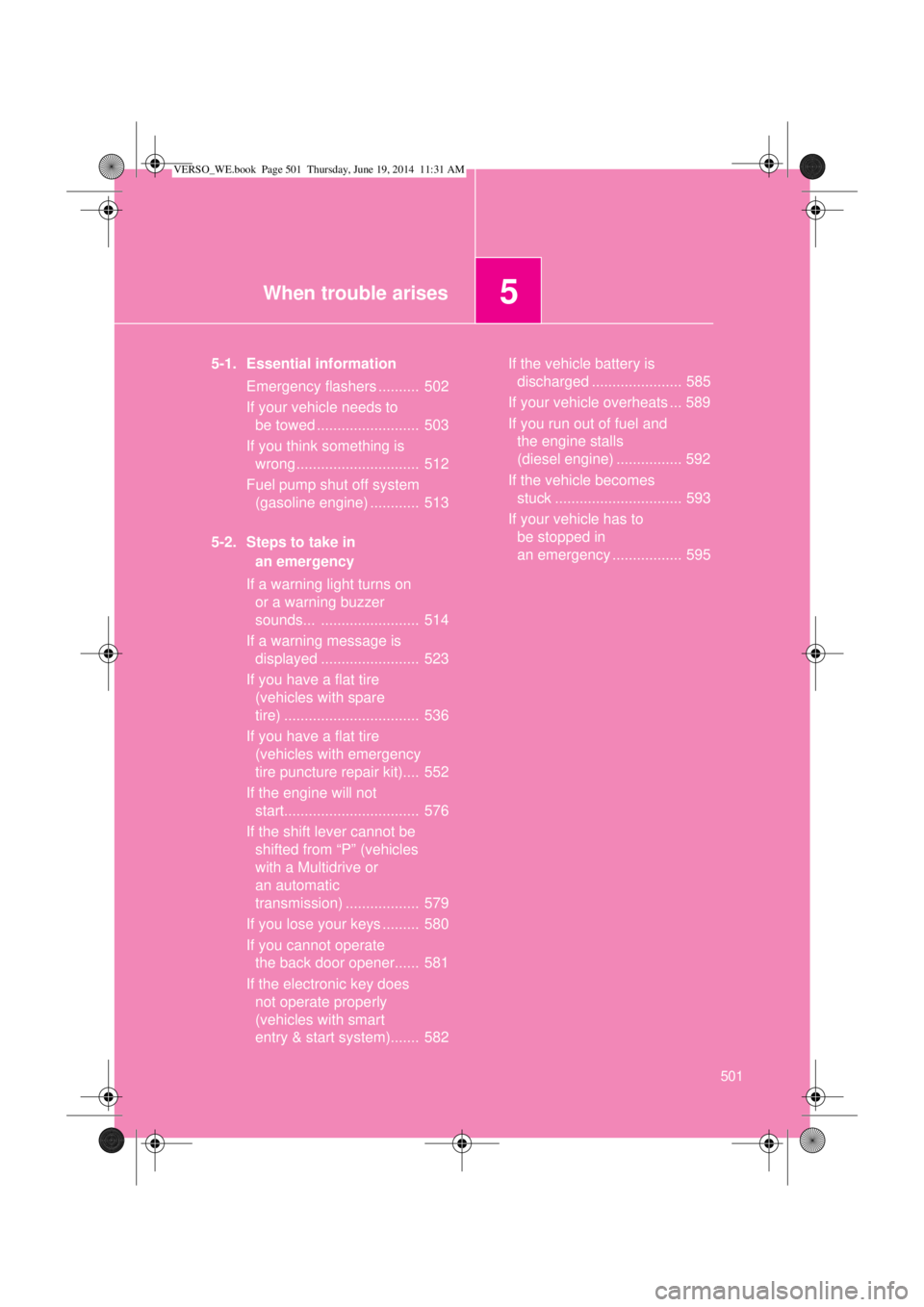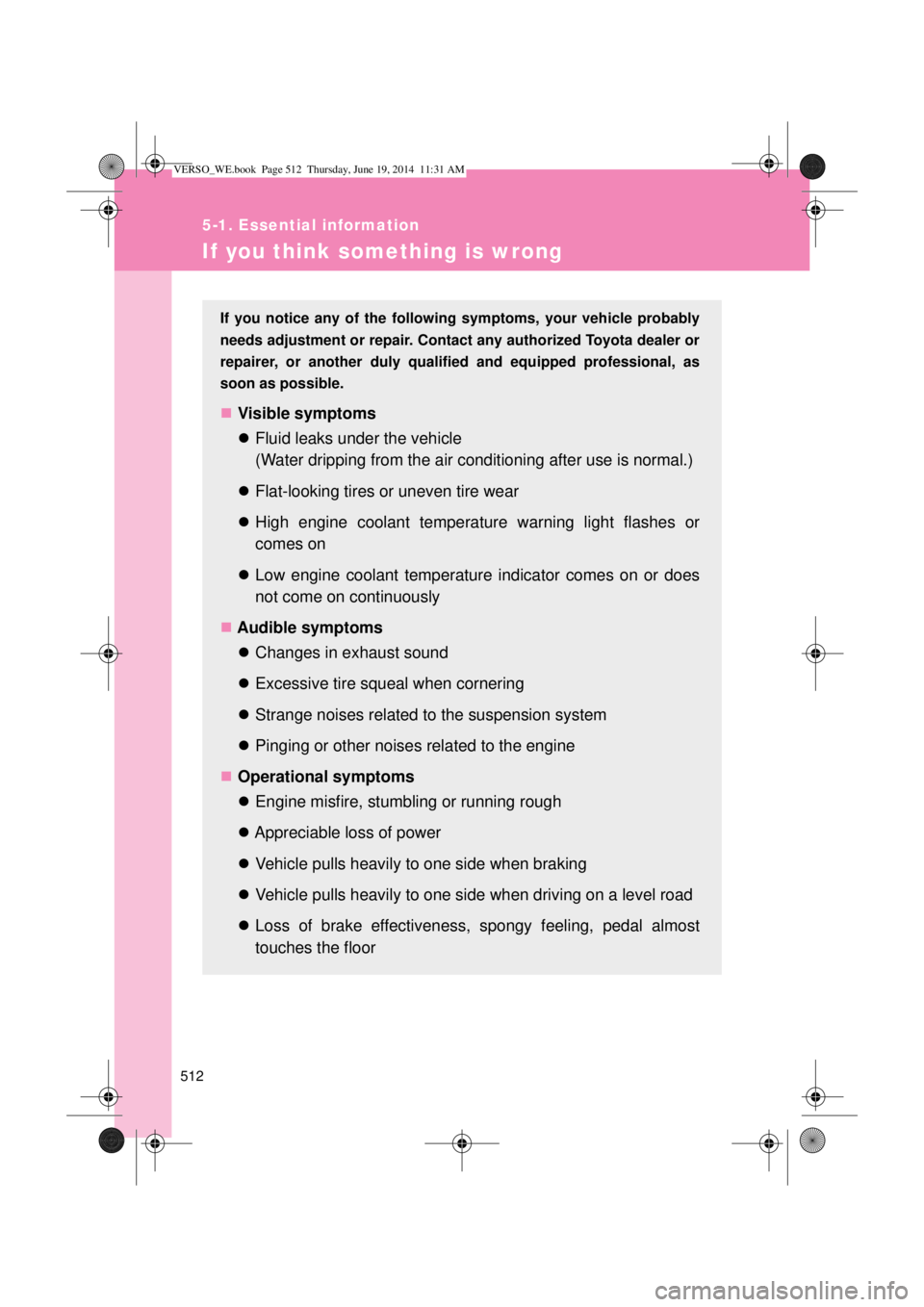2015 TOYOTA VERSO flat tire
[x] Cancel search: flat tirePage 456 of 650

456 4-3. Do-it-yourself maintenance
NOTICE
Repairing or replacing tires, wheels, tire pressure warning valves,
transmitters and tire valve caps (vehicles with the tire pressure warn-
ing system)
When removing or fitting the wheels, tires or the tire pressure warning
valves and transmitters, contact any authorized Toyota dealer or repairer,
or another duly qualified and equipped professional as the tire pressure
warning valves and transmitters may be damaged if not handled correctly.
Make sure to install the tire valve caps. If the tire valve caps are not
installed, water could enter the tire pressure warning valves and the tire
pressure warning valves could be bound.
When replacing tire valve caps, do not use tire valve caps other than those
specified. The cap may become stuck.
To avoid damage to the tire pressure warning valves and transmitters
(vehicles with the tire pressure warning system)
When a tire is repaired with liquid sealants, the tire pressure warning valve
and transmitter may not operate properly. If a liquid sealant is used, contact
any authorized Toyota dealer or repairer, or another duly qualified and
equipped professional or other qualified service shop as soon as possible.
Make sure to replace the tire pressure warning valve and transmitter when
replacing the tire. (P. 444)
Driving on rough roads
Take particular care when driving on roads with loose surfaces or pot holes.
These conditions may cause losses in tire inflation pressure, reducing the
cushioning ability of the tires. In addition driving on rough roads may cause
damage to the tires themselves, as well as the vehicle’s wheels and body.
If tire inflation pressures become low while driving
Do not continue driving, or your tires and/or wheels may be ruined.
VERSO_WE.book Page 456 Thursday, June 19, 2014 11:31 AM
Page 457 of 650

457
4-3. Do-it-yourself maintenance
4
Maintenance and care
Tire inflation pressure
Effects of incorrect tire inflation pressure
Driving with incorrect tire inflation pressure may result in the following:
Reduced fuel efficiency
Reduced driving comfort and tire life
Reduced safety
Damage to the drive train
If a tire needs frequent refilling, have it checked by any authorized Toyota
dealer or repairer, or another duly qualified and equipped professional.
Instructions for checking tire inflation pressure
When checking tire inflation pressure, observe the following:
Check only when the tires are cold.
If your vehicle has been parked for at least 3 hours and has not been
driven for more than 1.5 km or 1 mile, you will get an accurate cold tire
inflation pressure reading.
Always use a tire pressure gauge.
The appearance of the tire can be misleading. In addition, tire inflation
pressures that are even just a few pounds off can degrade ride and han-
dling.
Do not bleed or reduce tire inflation pressure after driving. It is normal for
the tire inflation pressure to be higher after driving.
Never exceed the vehicle capacity weight.
Passengers and luggage weight should be placed so that the vehicle is
balanced. Make sure to maintain the proper tire inflation pressure. Tire inflation
pressure should be checked at least once per month. However,
Toyota recommends that tire inflation pressure be checked once
every two weeks. (P. 621)
VERSO_WE.book Page 457 Thursday, June 19, 2014 11:31 AM
Page 458 of 650

458 4-3. Do-it-yourself maintenance
CAUTION
Proper inflation is critical to save tire performance
Keep your tires properly inflated. Otherwise, the following conditions may
occur and result in an accident causing death or serious injury.
Excessive wear
Uneven wear
Poor handling
Possibility of blowouts resulting from overheated tires
Poor sealing of the tire bead
Wheel deformation and/or tire separation
A greater possibility of tire damage from road hazards
NOTICE
When inspecting and adjusting tire inflation pressure
Be sure to reinstall the tire valve caps.
Without the valve caps, dirt or moisture could get into the valve and cause
air leakage, which could result in an accident. If the caps have been lost,
replace them as soon as possible.
VERSO_WE.book Page 458 Thursday, June 19, 2014 11:31 AM
Page 460 of 650

460 4-3. Do-it-yourself maintenance
When removing the wheel ornament (vehicles with the wheel cap clip)
When replacing wheels (vehicles with the tire pressure warning sys-
tem)
The wheels of your vehicle are equipped with tire pressure warning valves
and transmitters (except for spare tire) that allow the tire pressure warning
system to provide advance warning in the event of a loss in tire inflation
pressure. Whenever wheels are replaced, tire pressure warning valves and
transmitters must be installed.
(P. 444)
CAUTION
When replacing wheels
Observe the following precautions to reduce the risk of death or serious
injury.
Do not use wheels that are a different size from those recommended in the
Owner’s Manual, as this may result in loss of handling control.
Never use an inner tube in a leaking wheel which is designed for a tube-
less tire.
When installing the wheel nuts
Remove the wheel ornament using the
wheel cap clip.
Be sure to install the wheel nuts with
the tapered ends facing inward. Install-
ing the nuts with the tapered ends fac-
ing outward can cause the wheel to
break and eventually cause the wheel
to come off while driving, which could
lead to an accident resulting in death or
serious injury.Tapered
portion
VERSO_WE.book Page 460 Thursday, June 19, 2014 11:31 AM
Page 501 of 650

5When trouble arises
501
5-1. Essential information
Emergency flashers .......... 502
If your vehicle needs to
be towed ......................... 503
If you think something is
wrong .............................. 512
Fuel pump shut off system
(gasoline engine) ............ 513
5-2. Steps to take in
an emergency
If a warning light turns on
or a warning buzzer
sounds... ........................ 514
If a warning message is
displayed ........................ 523
If you have a flat tire
(vehicles with spare
tire) ................................. 536
If you have a flat tire
(vehicles with emergency
tire puncture repair kit).... 552
If the engine will not
start................................. 576
If the shift lever cannot be
shifted from “P” (vehicles
with a Multidrive or
an automatic
transmission) .................. 579
If you lose your keys ......... 580
If you cannot operate
the back door opener...... 581
If the electronic key does
not operate properly
(vehicles with smart
entry & start system)....... 582If the vehicle battery is
discharged ...................... 585
If your vehicle overheats ... 589
If you run out of fuel and
the engine stalls
(diesel engine) ................ 592
If the vehicle becomes
stuck ............................... 593
If your vehicle has to
be stopped in
an emergency ................. 595
VERSO_WE.book Page 501 Thursday, June 19, 2014 11:31 AM
Page 512 of 650

512
5-1. Essential information
If you think something is wrong
If you notice any of the following symptoms, your vehicle probably
needs adjustment or repair. Contact any authorized Toyota dealer or
repairer, or another duly qualified and equipped professional, as
soon as possible.
Visible symptoms
Fluid leaks under the vehicle
(Water dripping from the air conditioning after use is normal.)
Flat-looking tires or uneven tire wear
High engine coolant temperature warning light flashes or
comes on
Low engine coolant temperature indicator comes on or does
not come on continuously
Audible symptoms
Changes in exhaust sound
Excessive tire squeal when cornering
Strange noises related to the suspension system
Pinging or other noises related to the engine
Operational symptoms
Engine misfire, stumbling or running rough
Appreciable loss of power
Vehicle pulls heavily to one side when braking
Vehicle pulls heavily to one side when driving on a level road
Loss of brake effectiveness, spongy feeling, pedal almost
touches the floor
VERSO_WE.book Page 512 Thursday, June 19, 2014 11:31 AM
Page 518 of 650

518 5-2. Steps to take in an emergency
Tire pressure warning
light (if equipped)
When the light comes on:
Low tire inflation pressure
such as
• Natural causes (P. 520)
• Flat tire (P. 536, 552)Adjust the tire inflation pres-
sure to the specified level.
The light will turn off after a
few minutes. In case the
light does not turn off even
if the tire inflation pressure
is adjusted, have the sys-
tem checked by any
authorized Toyota dealer
or repairer, or another duly
qualified and equipped
professional.
When the light comes on
after blinking for 1 minute:
Malfunction in the tire pres-
sure warning system
(P. 521)Have the system checked
by any authorized Toyota
dealer or repairer, or
another duly qualified and
equipped professional.
(On the instru-
ment cluster)Driver’s and front passen-
ger’s seat belt reminder
light (warning buzzer)
*1
Warns the driver and front
passenger to fasten their
seat belts.Fasten the seat belts.
(On the center
panel)
(On the center
panel)Rear passenger’s seat
belt reminder light
(warning buzzer)
*2
Warns the rear passenger
to fasten his/her seat belt.Fasten the seat belt.
Warning lightWarning light/DetailsCorrection procedure
*4
*3
VERSO_WE.book Page 518 Thursday, June 19, 2014 11:31 AM
Page 519 of 650

5
519 5-2. Steps to take in an emergency
When trouble arises
*1: Driver’s and front passenger’s seat belt reminder:
The driver’s and front passenger’s seat belts reminder sounds to alert the
driver and front passenger that their seat belts are not fastened. The buzzer
sounds for 30 seconds after the vehicle has reached a speed of at least
20 km/h (12 mph). Then, if the seat belts are still unfastened, the buzzer will
sound in a different tone for 90 more seconds.
*2: Rear passenger’s seat belt reminders:
The rear passenger’s seat belt reminder sounds to alert the rear passenger
that his or her seat belt is not fastened. The buzzer sounds for 30 seconds
after the vehicle has reached a speed of at least 20 km/h (12 mph). Then, if
the seat belt is still unfastened, the buzzer will sound in a different tone for
90 more seconds.
*3: 5-passenger models
*4: 7-passenger models
Front passenger detection sensor and passenger seat belt reminder
If luggage is placed on the front passenger seat, the front passenger
detection sensor may cause the warning light to flash, even if a passen-
ger is not sitting in the seat.
If a cushion is placed on the seat, the sensor may not detect a passen-
ger, and the warning light may not operate properly.
When the tire pressure warning light comes on (vehicles with a tire
pressure warning light system)
Inspect the appearance of the tire to check that the tire is not punctured.
If the tire is punctured: P. 536, 552
If the tire is not punctured:
Carry out the following procedure after the tire temperature has lowered suffi-
ciently.
Check the tire inflation pressure and adjust to the appropriate level.
If the warning light does not go out even after several minutes, check that
the tire inflation pressure is at the specified level and carry out initialization.
The warning light may come on again if the above operations are conducted
without first allowing the tire temperature to lower sufficiently.
VERSO_WE.book Page 519 Thursday, June 19, 2014 11:31 AM